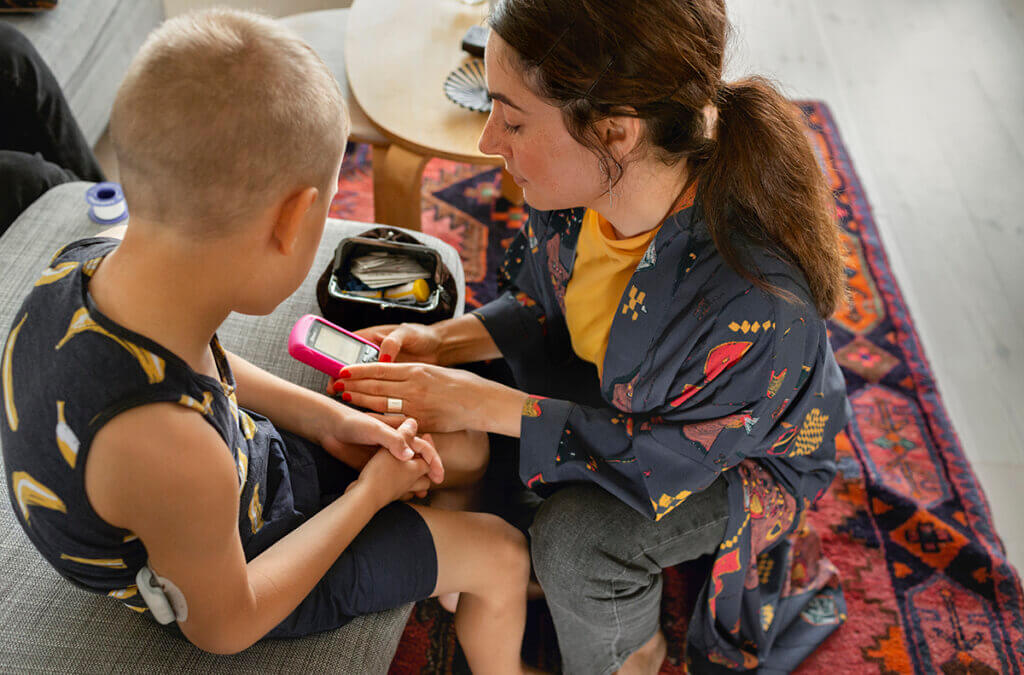A parent’s guide to handling everyday challenges for children with type 1 diabetes
From birthday cake temptation to fear of being different, type 1 diabetes can be tough for kids. Here’s how parents can help them overcome common challenges.

Caring for a child or children with type 1 diabetes can be hard enough when you’re at home and have the most control. But when your child is out in the big world, social pressures likely will add other challenges to the mix.
Here are 5 common situations you and your child might face, along with expert tips on how to handle them.
Challenge: Everybody else Is having cake
A classmate’s birthday party. A family celebration. Halloween. Throughout the year, there will be times when everyone is enjoying a special sweet treat. And it’s natural that your child will want one too.
The good news is that diabetes doesn’t mean all sugar is off-limits. But keeping your kid’s blood sugar under control means planning for such times. Don’t be shy about asking the host questions: What types of food will be served? What time will they be served? Can you share recipes or nutrition labels ahead of time?
You might decide that fitting a piece of cake into your child’s day is fine. As long as you watch serving sizes and change their insulin levels as needed, of course. It’s not the sweet treat that’s necessarily hard to manage, says Mila Ferrer, a program manager at Beyond Type 1. It’s the situation that’s tough.
It’s a good idea to let your child know what to expect ahead of time. You want to get them ready for what’s coming and fend off any disappointment. For example, try telling your child, “There will be cookies at the party. We will have only 1. You can pick the very best cookie. It will be so good!”
Pairing your glucometer with Wellframe, a digital health management app, lets you share your blood sugar levels with your care team for monitoring help. Many health plans offer Wellframe for free. Find out if yours does by reaching out to your insurer.
Challenge: Your child feels different from all the other kids
“Diabetes is a 24/7 condition,” says Toby Smithson, RD. Smithson is a registered dietitian, founder of Diabetes EveryDay, and co-author of Diabetes Meal Planning & Nutrition for Dummies. That means your child can’t hit pause on their condition just because they want to fit in at a sleepover or the movies. Like adults, kids can go through FOMO, or fear of missing out. And sometimes other kids aren’t kind about things that make people different.
“Type 1 diabetes can feel isolating and lonely,” says Ferrer. She suggests helping your child talk to their teachers and coaches about the disease. You can also ask them to educate other students. That can be empowering for your child. It can also help spread awareness. Giving their peers a better sense of their struggles can inspire more kindness.
It’s also helpful for kids with diabetes to spend time with others like them. Think about getting your child into a support group or diabetes camp. The American Diabetes Association and Children with Diabetes offer both. Another option is Beyond Type 1 Snail Mail Club. This pen pal program lets kids and teens with type 1 diabetes around the world connect with one another.
Challenge: Well-meaning adults say unhelpful things
Even adults who want to help may say hurtful things to children with type 1 diabetes. Comments such as, “I don’t think he can eat that!” or “Poor baby, with all those painful needles and pokes!” may make your child uncomfortable. Or it can undo your efforts to normalize insulin injections. Talk to your family, friends, teachers, and coaches about the language you and your child use to discuss their diabetes. This can help prevent innocent but damaging remarks.
Challenge: Recess!
Blood sugar levels can drop quickly during sports and active play. At the same time, they can also run high during or after intense exercise. That’s because all that activity can raise stress hormones that, in turn, raise glucose levels.
Do some (fun!) tests at home to understand how different types of activities affect your child. Check your kid’s blood sugar before, during, and after activities such as running, shooting hoops, or playing soccer. If you don’t have one, ask your child’s endocrinologist for a trial continuous glucose monitor. This device makes it easier to spot patterns. Then use what you learn to change insulin dosing or snacking as needed before and after sports.
You may learn that it’s best to lower your child’s insulin dose before sports to keep their blood sugar in a safe range. Or maybe they need a small carbohydrate snack before they play. If your child is older, encourage them to check their own levels before joining in games with their friends. If numbers are too high or low, they may need to sit this one out.
Challenge: Your kiddo wants to manage their diabetes without you
Yes, it might be scary to let go of a little control to your child. Depending on their age and their pediatrician’s advice, getting them involved isn’t a bad thing.
“All parents have the ultimate responsibility, when the child is ready, to shift the responsibility for a child to the child,” says Smithson. For younger kids, this may look more like having them help with alcohol wipes at injection sites. Or they can read food labels aloud to help you count carbs. But when kids reach adolescence, it’s appropriate to start giving them more responsibility.
It’s okay to do this in baby steps and work side by side with your teen. Stand by as they check their own blood glucose numbers. Keep an eye out as they pack a supply bag with a glucose meter, juice, and snacks. Help them out by placing glucose meters in strategic locations, such as next to their bed or at the kitchen table. It’s a good visual reminder to check their glucose at important times, such as before bed, upon waking, and around meals. Then you don’t have to nag, and they build confidence about managing their own care.
